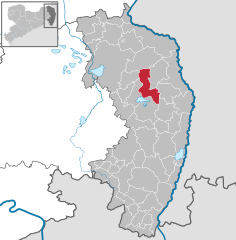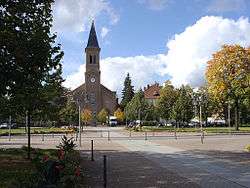Niesky
| Niesky | ||
|---|---|---|
|
Zinzendorf Square with Moravian Church | ||
| ||
 Niesky | ||
Location of Niesky within Görlitz district 
 | ||
| Coordinates: 51°18′N 14°49′E / 51.300°N 14.817°ECoordinates: 51°18′N 14°49′E / 51.300°N 14.817°E | ||
| Country | Germany | |
| State | Saxony | |
| District | Görlitz | |
| Government | ||
| • Mayor | Beate Hoffmann (previously : W.Rückert) | |
| Area | ||
| • Total | 53.61 km2 (20.70 sq mi) | |
| Population (2015-12-31)[1] | ||
| • Total | 9,607 | |
| • Density | 180/km2 (460/sq mi) | |
| Time zone | CET/CEST (UTC+1/+2) | |
| Postal codes | 02906 | |
| Dialling codes | 03588 | |
| Vehicle registration | GR | |
| Website | www.niesky.de | |

Niesky (-German, Sorbian/Polish: Niska) is a small town in Upper Lusatia in eastern the Free State of Saxony, Germany. It has a population of about 11,000 and is part of the district of Görlitz.
The town was founded in 1742 by Moravian immigrants. As members of the Moravian Church, they fled from persecution in their Catholic homeland. The name Niesky is the Germanised version of the Czech word nízký ("low"). In 1776, at the age of 12, Benjamin Henry Boneval Latrobe, future designer of the United States Capitol, as well as of the Baltimore Basilica, was sent to the Moravian School at Niesky.
In 1926 the architect Konrad Wachsmann worked in the timber construction firm Christoph & Unmack AG.
Localities of Niesky are Neuhof, Neusärchen, Neuödernitz, Ödernitz, See, Zeche-Moholz, Kosel, Zedlig and Sandschänke.
Twin Town
Niesky is twinned with the ![]() French town of Albert.
French town of Albert.
 Town hall
Town hall Raschke's house
Raschke's house Wooden house (by Christoph & Unmack AG)
Wooden house (by Christoph & Unmack AG) Wooden house
Wooden house
References
| Wikimedia Commons has media related to Niesky. |

.svg.png)